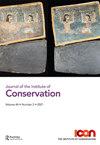爱尔兰国家博物馆最近发现的沼泽尸体的保护处理
IF 1
0 HUMANITIES, MULTIDISCIPLINARY
引用次数: 0
摘要
沼泽体包含了丰富的信息,当被尊重和敏感地对待时,它为学者和公众提供了一个与我们的过去“面对面”的机会。在过去的20年里,在爱尔兰发现了8具沼泽尸体,本文描述了其中3具的保护情况。评估了过去的保存技术及其结果,以最佳地规划尸体的处理,选择的保存方法是使用聚乙二醇(PEG)冷冻干燥。这种技术有局限性,因为处理后的最终视觉外观显示保存完好的软组织。处理的结果与这一预期一致,并促使人们建议在博物馆对沼泽尸体进行任何进一步处理之前,进一步研究新的保护技术。本文章由计算机程序翻译,如有差异,请以英文原文为准。
Conservation treatment of recently discovered bog bodies at the National Museum of Ireland
Abstract Bog bodies contain a wealth of information and when treated with respect and sensitivity present an opportunity for scholars and the public to come ‘face to face’ with our past. Eight bog bodies have been discovered in Ireland in the past 20 years and the conservation of three of these is described in this article. Past conservation techniques and their results were assessed to best plan the treatment for the bodies, with the conservation method selected being freeze-drying using poly-ethylene-glycol (PEG). This technique has limitations due to the final visual appearance after treatment of bodies which exhibit well preserved soft tissue. The results of the treatment were consistent with this expectation and have prompted a recommendation for further research into new techniques for conservation before any further treatment of bog bodies is undertaken at the museum.
求助全文
通过发布文献求助,成功后即可免费获取论文全文。
去求助
来源期刊

Journal of the Institute of Conservation
HUMANITIES, MULTIDISCIPLINARY-
CiteScore
1.50
自引率
0.00%
发文量
22
期刊介绍:
The Journal of the Institute of Conservation is the peer reviewed publication of the Institute of Conservation (Icon). As such, its aims reflect those of Icon, to advance knowledge and education in conservation and achieve the long term preservation and conservation of moveable and immoveable cultural heritage. The Journal provides a collective identity for conservators; it promotes and supports both the profession and professionalism. With international contributions on all aspects of conservation, it is an invaluable resource for the heritage sector. The specific aims of the Journal are to: 1. promote research, knowledge and understanding of cultural heritage conservation through its history, practice and theory 2. provide an international forum to enable and disseminate advances in research, knowledge and understanding relating to conservation and heritage 3. champion and support professional standards of heritage conservation in the UK and internationally 4. provide a permanent record of issues relating to conservation and heritage 5. be financially and operationally sustainable. To achieve these aims, the Journal invites contributions from all those involved in the conservation of cultural heritage and related activities. Areas of interest include understanding cultural heritage materials and their degradation; subject reviews and histories of cultural heritage materials and conservation treatments; new, innovative or improved approaches to conservation and collections care theory, practice, communication, management and training; case studies demonstrating new, innovative or improved approaches; and conservation in its wider context. Submitters are encouraged to demonstrate how their work is of practical application to conservation. To maintain professional standards and promote academic rigour, submissions of articles and shorter notices are subject to an anonymous peer review process.
 求助内容:
求助内容: 应助结果提醒方式:
应助结果提醒方式:


